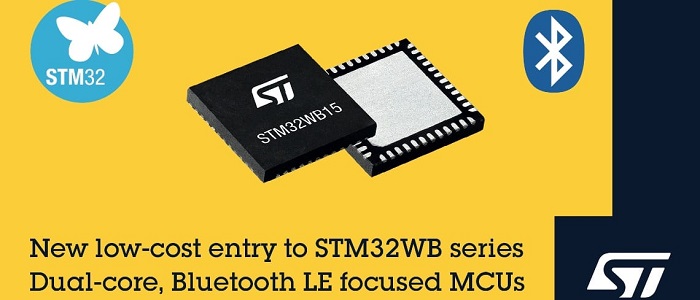ST is sampling today the STM32WB15 and STM32WB10, the first Bluetooth 5.2 compliant wireless microcontrollers with 320 KB of flash and 48 KB of RAM. Both devices open the door to new applications since they offer the lowest RAM configuration and the lowest power consumption of the STM32WB series with an active mode of only 33 µA/MHz. As a result, engineers can create more cost-effective solutions or save even more battery life. As wireless applications continue to integrate smaller products, the new devices allow engineers to tailor their bill of materials better. Hence, the new devices also adopt a small footprint and only offer one package with 48 pins. It also explains why the new models have fewer peripherals.
STM32WB15, STM32WB10: Bringing Wireless MCUs to More Systems
The first STM32 wireless MCU became available in 2019. Since then, ST has expanded the series to make it more accessible. For instance, the STM32WB35 and STM32WB30 lowered the bill of materials thanks to lower memory configurations. In fact, they were symbolic because, for the first time, the volume price for an STM32WB was less than two dollars. More recently, the first wireless MCU became available as a module under the STM32WB55MMG. By integrating the antenna, crystals, and the microcontroller under one roof, designers could start releasing designs faster. Indeed, engineers no longer have to worry about certifications or antenna tuning, thus enabling a quicker market release. The new STM32WB15 and STM32WB10 follow the same trajectory by further lowering the barrier to entry to this family of MCUs.
STM32WB15, STM32WB10: When Less Is More
The new models retain the basic architecture that made STM32WB popular. ST still includes a Cortex-M4 for the application and a Cortex-M0+ for the wireless protocol. The devices can run a full certified Bluetooth Low Energy certified stack thanks to its SDK, or proprietary protocols thanks to its host controller interface or Bluetooth Low-Level driver interface. The only difference between the new STM32WB15 and STM32WB10 is that the former has extended cryptographic performances and an integrated SMPS for further power consumption applications. Hence, applications that require Bluetooth LE and a fairly generous MCU but that won’t need over-the-air updates, or a lot of RAM can benefit from a new price point that makes the STM32WB even more accessible.
Further information can be found at www.st.com







